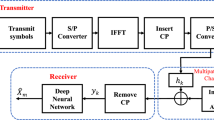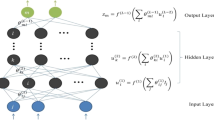Abstract
The essential criteria of wireless communication system are accurate signal identification. The channel assessment and adjustment are the two most critical mechanisms for signal identification. Since orthogonal frequency division multiplexing (OFDM) used to decrease bit error rates in current wireless communication systems and to optimize spectral efficiency and compared to a single carrier network, secure channel compensation method. Nevertheless, the system’s quality output is degraded depending on the channel state due to the incorrect channel approximation and noise amplification through the channel compensation procedure. In this paper, a 1D Convolutional Neural Network (CNN) deep learning model to estimate the channel provided and the equalized data also recovered. The Deep Neural Network (DNN) can not only use the channel variation features from previous estimates with correctly chosen outputs, but it can also derive additional features from the pilots and receiving signals. To prove the ability of this model the Bit Error Rate (BER) for the recovered data is compared with the conventional models like Minimum Mean Square Error (MMSE) and Least Square (LS) and compared with the Feed Forward Neural Network (FFNN) model in different digital modulation techniques.












Similar content being viewed by others
Explore related subjects
Discover the latest articles and news from researchers in related subjects, suggested using machine learning.Change history
09 June 2022
This article has been retracted. Please see the Retraction Notice for more detail: https://doi.org/10.1007/s12652-022-04096-1
References
Albreem MAM (2015) 5G wireless communication systems: vision and challenges. I4CT. https://doi.org/10.1109/i4ct.2015.7219627
Cammerer S, Gruber T, Hoydis J, Brink ST (2017) Scaling deep learning-based decoding of polar codes via partitioning. In: Proceedings of IEEE global communication conference (GLOBECOM), Singapore, pp 1–6
Cheng C-H, Huang Y-H, Chen H-C (2016) Channel estimation in OFDM systems using neural network technology combined with a genetic algorithm”. Soft Comput 20(10):4139–4148
Coleri S, Ergen M, Puri A, Bahai A (2002) Channel estimation techniques based on pilot arrangement in OFDM systems. IEEE Trans Broadcast 48(3):223–229
Dobre OA, Abdi A, Bar-Ness Y, Su W (2007) Survey of automatic modulation classification techniques: classical approaches and new trends. IET Commun 1(2):137–156
Gao X, Jin S, Wen C-K, Li GY (2018) ComNet: combination of deep learning and expert knowledge in OFDM receivers. IEEE Commun Lett 22(12):2627–2630
Gruber T, Cammerer S, Hoydis J, Brink S (2017) On deep learning-based channel decoding. http://arxiv.org/abs/1701.07738
Haykin S (1999) Neural networks: a comprehensive foundation, 2nd edn. Prentice-Hall, Englewood Cliffs
He H, Jin S, Wen C-K, Gao F, Li GY, Xu Z (2018a) Model driven deep learning for physical layer communications. https://arxiv.org/abs/1809.06059
He H, Wen C-K, Jin S, Li GY (2018b) A model-driven deep learning network for MIMO detection. https://arxiv.org/abs/1809.09336
He H, Wen C-K, Jin S, Li GY (2018c) Deep learning-based channel estimation for beamspace mmwave massive MIMO systems. IEEE Wireless Commun Lett 7(5):852–855
Hornik K, Stinchcombe M, White H (1989) Multilayer feedforward networks are universal approximators. Neural Netw 2(5):359–366
Huang H, Xia W, Xiong J, Yang J, Zheng G, Zhu X (2018) Unsupervised learning-based fast beamforming design for downlink MIMO. IEEE Access 7:7599–7605
Karra K, Kuzdeba S, Petersen J (2017) Modulation recognition using hierarchical deep neural networks. In: Proceedings of IEEE International Symposium on dynamic spectrum access networks (DySPAN), Maryland, MD, USA, pp 1–3
Krishnaveni P, Sutha J (2020) Novel deep learning framework for broadcasting abnormal events obtained from surveillance applications. J Ambient Intell Humaniz Comput
Krizhevsky A, Sutskever I, Hinton GE (2012) ImageNet classification with deep convolutional neural networks. Commun ACM 60(2):84–90. https://doi.org/10.1145/3065386
Li Y, Cimini LJ, Sollenberger NR (1998) Robust channel estimation for OFDM systems with rapid dispersive fading channels. IEEE Trans Commun 46(7):902–915
Li Y, Cheng X, Gui G (2018) Co-robust-ADMM-net: joint ADMM framework and DNN for robust sparse composite regularization. IEEE Access 6:47943–47952
Liang F, Shen C, Wu F (2018) An iterative BP-CNN architecture for channel decoding. IEEE J Sel Top Signal Process 12(1):144–159
Liu M, Song T, Gui G (2018) Deep cognitive perspective: resource allocation for NOMA based heterogeneous iot with imperfect SIC. IEEE Internet Things J 6(2):2885–2894
Ma X, Ye H, Li Y (2018) Learning assisted estimation for time-varying channels. In: Proceedings of 15th international symposium on wireless communication systems (ISWCS), Lisbon, Portugal, pp 1–5
Maier D, Moser S, Slomka F (2015) Deterministic models of the physical layer through signal simulation. In: 8th international conference on simulation tools and techniques (SIMUTools 2015), Athens, Greece: ICST, pp 175–182. https://doi.org/10.4108/eai.24-8-2015.2261106
Mehmood F, Ullah I, Ahmad S, Kim DH (2019) Object detection mechanism based on deep learning algorithm using embedded IoT devices for smart home appliances control in CoT. J Ambient Intell Humaniz Comput
Mu R, Zeng X (2019) A review of deep learning research. KSII Trans Internet Inf Syst 13(4):1738–1764
Nachmani E, Marciano E, Lugosch L, Gross WJ, Burshtein D, Be’ery Y (2018) Deep learning methods for improved decoding of linear codes. IEEE J. Sel Top Signal Process 12(1):119–131
O’Shea T, Hoydis J (2017) An introduction to deep learning for the physical layer. IEEE Trans Cogn Commun Netw 3(4):563–575
Omar S, Ancora A, Slock DTM (2008) Performance analysis of general pilot-aided linear channel estimation in LTE OFDMA systems with application to simplified MMSE schemes. In: Proceedings of IEEE 19th International symposium personal indoor and mobile radio communications, pp 1–6
Qin Z, Ye H, Li GY, Juang B-HF (2018) Deep learning in physical layer communications. https://arxiv.org/abs/1807.11713
Rajendran S, Meert W, Giustiniano D, Lenders V, Pollin S (2018) Deep learning models for wireless signal classification with distributed low-cost spectrum sensors. IEEE Trans Cognit Commun Netw 4(3):433–445
Rao X, Li Z, Yang Y (2019) Device-free passive wireless localization system with transfer deep learning method. J Ambient Intell Humaniz Comput
Samuel N, Diskin T, Wiesel A (2017) Deep MIMO detection. In: Proceedings of IEEE 18th international workshop on signal processing advances in wireless communications (SPAWC), pp 1–5
Schmidhuber J (2015) Deep learning in neural networks: an overview. Neural Netw 61:85–117
Šimko M, Mehlführer C, Wrulich M, Rupp M (2010) Doubly dispersive channel estimation with scalable complexity. In: Proceedings of International ITG Workshop Smart Antenna (WSA), pp 251–256
Soltani M, Pourahmadi V, Mirzaei A, Sheikhzadeh H (2019) Deep learning-based channel estimation. IEEE Commun Lett 23(4):652–655
Sun H, Chen X, Shi Q, Hong M, Fu X, Sidiropoulos ND (2017) Learning to optimize: training deep neural networks for wireless resource management. In: Proceedings of IEEE 18th International workshop on signal processing advances in wireless communications (SPAWC), Sapporo, Japan, pp 1–6
Wang Y, Guo J, Li H, Li L, Wang Z, Wang H (2017a) CNN-based modulation classification in the complicated communication channel. In: Proceedings of the 13th IEEE International conference on electronic measurement and instruments, ICEMI 2017, pp 512–516, China
Wang T, Wen C-K, Wang H, Gao F, Jiang T, Jin S (2017b) Deep learning for wireless physical layer: opportunities and challenges. China Commun 14(11):92–111
Wen C-K, Shih W-T, Jin S (2018) Deep learning for massive MIMO csi feedback. IEEE Wireless Commun Lett 7(5):748–751
Wu Y, Li X, Fang J (2018) A deep learning approach for modulation recognition via exploiting temporal correlations. In: Proceedings of IEEE 19th International workshop on signal processing advancrs in wireless communications (SPAWC), Maryland, MD, USA, pp 1–5
Ye H, Li GY, Juang B-H (2018) Power of deep learning for channel estimation and signal detection in OFDM systems. IEEE Wireless Commun Lett 7(1):114–117
Young T, Hazarika D, Poria S, Cambria E (2018) Recent trends in deep learning based natural language processing. IEEE Comput Intell Mag 13(3):55–75
Acknowledgements
This work is for the research purpose and no funding provided.
Author information
Authors and Affiliations
Corresponding author
Additional information
Publisher's Note
Springer Nature remains neutral with regard to jurisdictional claims in published maps and institutional affiliations.
This article has been retracted. Please see the retraction notice for more detail: https://doi.org/10.1007/s12652-022-04096-1
About this article
Cite this article
Ponnaluru, S., Penke, S. RETRACTED ARTICLE: Deep learning for estimating the channel in orthogonal frequency division multiplexing systems. J Ambient Intell Human Comput 12, 5325–5336 (2021). https://doi.org/10.1007/s12652-020-02010-1
Received:
Accepted:
Published:
Issue Date:
DOI: https://doi.org/10.1007/s12652-020-02010-1




